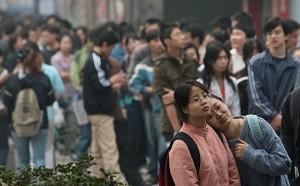CHINA—According to the Beijing Youth Daily , China Youth & Children Research Center (CYCRC) reported that university tuition is 25 times higher now than it was 18 years ago. The percentage increase is almost ten times higher than salary increases for urban residents during the same time period. Expenses for children’s’ education exceeds that of retirement and housing costs and has become the No.1 expense for Chinese households.
The report was published on January 10, 2007. Currently, university fees in China range from 5,000 to 10,000 yuan (approximately US$641 to $1,282) per annum, which is 25 times higher than it was in 1989. Personal income of urban residents increased only 2.3 fold.
Twenty years ago the average fee for higher education went from zero to 200 yuan (approximately US$25) per annum. By 1995 it was 800 yuan (approximately US$102) per annum, and by 2005 it was 5000 yaun (approximately US$641). Adding housing and living expenses, an average university student will spend 40,000 yuan (approximately US$5,129) in four years. However, China doesn’t have a student loan system, which would allow students to borrow money from the government and pay it back after they start working. A researcher from CYCRC said that “saving for their education” is the top motivation for Chinese people now.
The Chinese government isn’t allocating enough funds for education and thus the people are carrying the burden of obtaining an education. In certain regards, the increase in tuition is already interfering with people’s daily living standards. Many households are suffering because they are paying university expenses. Sun Jiye, a member of the National Committee of the Chinese People’s Political Consultative Conference, said, “The most difficult thing for a family is for the children to go to college. Most people qualify for admission but just can’t afford to pay the fees. A family’s income from an entire year isn’t enough for a child’s college tuition. With just one person attending college the whole family can fall into poverty.”
Students in other countries usually pay about 15 percent of the actual costs. In China, the student share is about 44 percent. The decrease in governmental funding in education in recent years has made it difficult for Chinese students.
Education departments in China were recently accused of illegally charging over 1.7 billion yuan (US$200 million) in fees. The Department of Education said that they have not adjusted the standard college fees since 2000; -“however, it is very difficult to estimate the cost of educating students since there are so many factors involved.”
Obtaining a university education has become a top concern for the Chinese people in recent years. The book The Fading University analyses the ability of people to obtain a university education in the 1930s compared with now.
In the 1930s, national universities charged 22 to 40 silver yuan per annum, normal colleges were free, private universities charged 45 to 120 silver yuan per annum, and church universities charged 160 silver yuan. Back then, an average worker earned 264 silver yuan per year. Hence in the 30s, a student from an average family could afford to go to an elite school, such as Beijing University or Tsinghua University. In 2005, an average university student spent 10,000 yuan (approximately US$1,282) per year. A farmer from a village makes 2,936 yuan (approximately US$376) per year. It would take 13 years to pay for a college education, assuming he doesn’t spend the money elsewhere.





